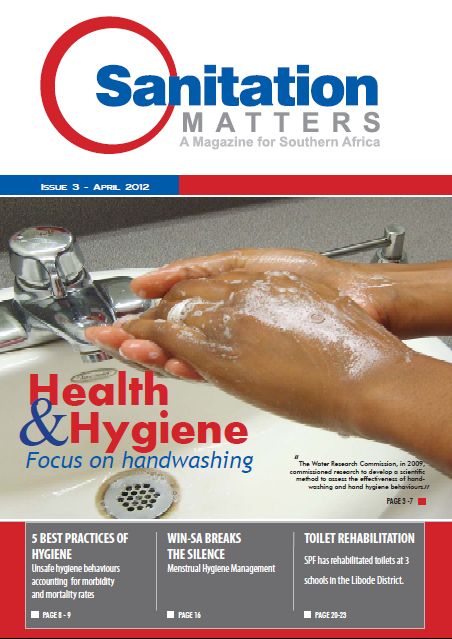
Published in: 2012
Publisher:
Issue 3 - April 2012, Water Information Network, South Africa
Author:
WIN
Uploaded by:
SuSanA secretariat
Partner profile:
common upload
6371 Views
75 Downloads
Content - Summary
Content in this issue:
A Tool For Measuring The Effectiveness Of Handwashing 3-7
Wilkinson, M.
Human hands are one of the chief vehicles of transmission of diarrhoeal disease, especially the hands of mothers and other caregivers. Good hand hygiene plays a significant role in preventing and minimising these diseases.
+++++++
Five Best Practices Of Hygiene Promotion Interventions In the WASH Sector 8-9
The objective of this article is to assist hygiene promotion (HP) practitioners and planners to make HP programmes better by providing indications of what works in HP interventions. It is also a humble first step to encourage researchers to look at how best practices can support cost effectiveness studies and contribute to sustainable positive behaviour adoption with regards to the MDGs and beyond.
+++++++
Washing Your Hands With Soap: Why Is It Important? 10-11
Kings, J.
There is a very good reason why we have GLOBAL HANDWASH DAY in
October, AND WHY COUNTRIES AROUND THE WORLD HAVE RECOGNISED
THE IMPORTAMCE OF THIS SIMPLE ACTIVITY: The critical factor in disease
transmission is a dirty skin transmitting germs onto food, dishes and other people.
+++++++
Appropriate Sanitation Infrastructure At Schools Improves Access To Education 12-13
CSIR Science Scope
Good physical infrastructure at schools enhances access to education, while inadequate and poorly maintained infrastructure excludes learners
+++++++
Management Of Menstruation For Girls Of School Going Age: Lessons
Learnt From Pilot Work In Kwekwe 14 -15
Neseni, N.
The Institute of Water and Sanitation Development has been working on a pilot project on how to improve sanitation facilities to be more girls friendly. The current VIP latrine, considered to be of sound scientific quality in controlling smells and flies, falls short in meeting the needs
of the girl child.
+++++++
WIN-SA Breaks The Silence On Menstrual Hygiene Management 16
Stockholm Environment Institute (SEI).
The dialogue was attended by over sixty (60) delegates who represented
national and provincial departments, donor and development agencies,
academic institutions, trade unions, civil society organisations and the
private sector.
+++++++
Joining Hands To Help Keep Girls In Schools 17
Mabunda, H.
It has been reported that about 1 in 10 school-age African girls do not attend school during menstruation. This suggests that girls are forced to be absent during their period, and thereby lose critical learning time.
+++++++
The Girl-Child And Menstrual Management: The Stories Of Young Zimbabwean Girls. 18-19
Kanyemba, A.
The primary aims of the booklet is to disseminate knowledge to the school girls and also to provide useful knowledge and advice which can help each girl practically. The booklet includes real stories told by the Zimbabwean girls. It was tested with the school girls to ensure relevancy and clarity of messages.
+++++++
Toilet Rehabilitation At Nciphizeni JSS And Mtyu JSS Schools 20 - 23
One of the objectives of the Protecting Futures Programme is to ensure
that girl children are awarded an opportunity that will secure a safe future for them. In order to achieve this objective, SPF undertook a survey of the condition of the toilets of all 15 selected schools in the
Libode District. The outcome of the survey enabled SPF to prioritise 3 schools for toilet rehabilitation.
+++++++
Celebratiing 100% sanitation 24 - 26
Village Water Zambia (VWZ)
100% sanitation concept was introduced by Village Water Zambia (VWZ) in its project areas in 2009. This approach came as a solution to the challenges that VWZ faced with the already existing approaches to sanitation.
Bibliographic information
WIN (2012). Sanitation Matters - Health & hygiene, focus on handwashing. Issue 3 - April 2012, Water Information Network, South Africa
Filter tags
English Menstrual Health and Hygiene (MHH) Schools Sub-Saharan Africa














